Evaluating Surface Cleanliness Using a Risk-Based Approach
Rinse sample analysis or visual inspection are risk-based approaches that can be correlated to surface cleanliness to replace surface sampling in a biopharmaceutical equipment cleaning process.
TRAIMAK/shutterstock.com
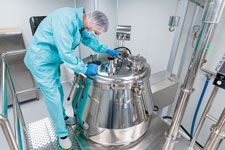
Regulated companies that use automated cleaning applications have always struggled with correlating rinse sample quality or visual inspection to surface cleanliness. The process typically involves performing 100% spray coverage testing, rinse recovery testing, specific or non-specific analytical method qualification, surface sampling and recovery testing of the sampling technique, and visual inspection performed during the cleaning validation. Each element of the justification needs to be reviewed and evaluated during the cleaning process design stage to defend a lean approach in continuously monitoring the cleaning process. A risk-based approach, supplemented with laboratory studies and information from published literature, can be leveraged in the justification to reduce testing during cleaning qualification and continuous monitoring stages without impacting quality. Laboratory results from total organic carbon (TOC) and conductivity rinse sample for an alkaline detergent along with determining visible residue limits using multiple concentrations, light intensity, viewing angles, inspectors, and distances have been used by multiple biopharmaceutical companies. This approach has helped correlate rinse sample quality or visual inspection and justify a lean approach to continuously monitoring surface cleanliness.
Cleaning validation regulatory guidance
FDA’s 1998 cleaning validation guidance document focuses on general aspects and qualification of the cleaning process (1). The design and post-validation monitoring aspects are factored into the validation process, but are not specified in the regulatory guide nor in the industry practices. Today, this is referred to as the old or traditional approach to validation. Other countries used a similar approach to provide guidance to the industry of the regulatory expectations regarding cleaning and cleaning validation (2–3).
In 2011, FDA issued a revised process validation guidance document that introduced a concept known today as the product lifecycle model (4). This model separates the various steps and activities of validation into three stages: process design, process qualification, and continuous process verification. Since then, the lifecycle model has become the “gold standard” for all types of processes including cleaning validation; it provides a better understanding of the design and monitoring of the cleaning process (see Figure 1) and, consequently, it ensures a more robust cleaning validation program.
Figure 1. Example of cleaning validation activities in a lifecycle model. (All figures are courtesy of the authors.)
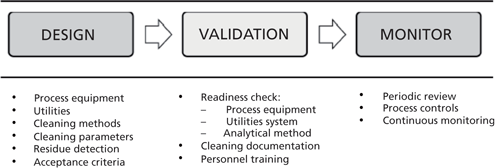
Along with the process lifecycle approach, other guides have been issued by FDA and the International Council for Harmonization (ICH), which include the concepts of quality by design (QbD), risk management, and process analytical technology (PAT) (5, 6). The purpose of these guidance documents is to promote enhanced understanding of products and processes, to build quality into manufacturing, and to provide the basis for continuous improvement of products and processes. Figure 2 shows the correlation between these documents and the lifecycle model. Consequently, the lifecycle model places more attention on understanding the process and its design, and continued monitoring of the operation to ensure the expected results. By comparison, the old validation approach placed most efforts on qualifying the process rather than understanding it.
Figure 2. Correlation between the lifecycle model, International Council for Harmonization (ICH), and process analytical technology (PAT) guidance documents.
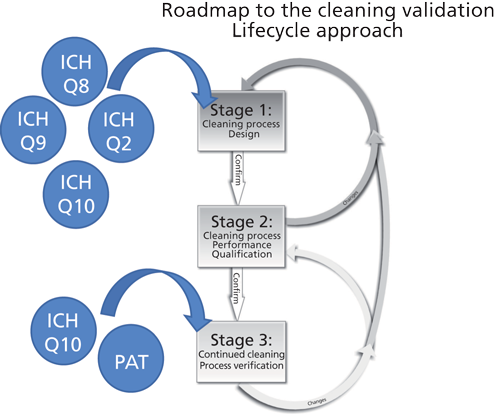
Cleaning in the GMP industry is a critical process intended to prevent or, in more modern terms, reduce risk of contaminating the subsequent product with undesirable residues that may impact patient safety. For that reason, it is important to make the right connection between rinse sampling and/or visual inspection to surface cleanliness. Reducing the risk requires good understanding of the cleaning process. Some aspects of the lifecycle model must be considered to ensure that surface cleanliness not only is feasible and consistent but also relates to patient safety. Figure 3 depicts a workflow that helps bridge the gap between sampling to surface cleanliness, which will be discussed in more detail.
Figure 3. Workflow to bridge the gap between sampling and surface cleanliness.
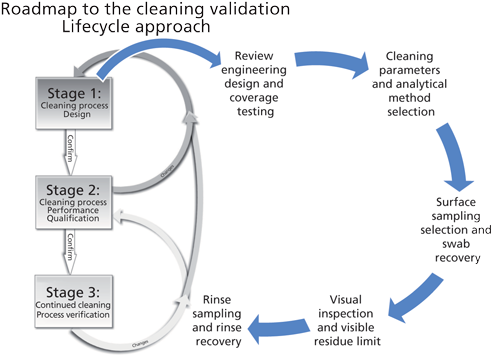
Review engineering design and coverage testing
The design of the process equipment must be considered to ensure that the cleaning recommendations can be successfully scaled-up from laboratory-scale experiments. For automated clean-out-of-place (COP) and clean-in-place (CIP) applications, it is important to review coverage and flow velocity in vessels and piping, drainability of the wash and rinse solutions, surface finish, and materials of construction (7–9).
Spray devices should cover all the surfaces that they are intended to clean. These types of devices can be fixed or dynamic. Riboflavin (vitamin B2) testing using 0.2 g/L vitamin B2 and an ultraviolet (UV) light ensures that the spray device gives full coverage during the wash and rinse steps. For vertical tanks, the flow rate of a static spray device should be about 2.5–3 gallons per minute per feet of internal tank diameter (10). Vessel inserts such as agitators, probes, and baffles may be challenging to clean in place and hence, coverage testing becomes more crucial to designing for a successful cleaning.
Flow rates in piping are important for proper coverage of solutions, as is providing turbulent flow. The flow velocity in piping should be five feet per second (approximately 1.5 m/s) to prevent air entrapment at vertical elbows. Dead legs should be minimized, and the length-to-diameter ratio of less than or equal to 1.5 is preferred. Dead legs should also be oriented at an angle to allow for full coverage and drainage during washing and rinsing.
The drainage of wash and rinse solution is also important. Pooling in vessels and piping may lead to microbial blooms, biofilm, and carryover of process and cleaning agent residues. The mixing of the drain solution (heel) can reduce residue deposition on the side walls. Horizontal tanks, equipment surfaces, and piping should be sloped at 1/8–1/16 inches per square foot (3.6–1.8 cm per square meter) to allow full drainage.
The preferred materials of construction in the pharmaceutical industry are 304 and 316L stainless steel. Other materials of construction are used throughout the industry. The selection of materials should be based on both the manufacturing process and on the cleaning procedure required for reducing the amount of residue to safe levels. Surface roughness as well as other materials of constructions in use should be included in the laboratory studies to ensure that such levels do not adversely impact cleanability and recovery of residues.
Cleaning agent and analytical method selection
Cleaning agents should be selected based on laboratory studies that simulate the process soil, soil condition, and cleaning method used, as well as performing a supplier qualification and technical support review. Further consideration should be given to formulation, toxicity, analytical method for residuals, rinsability of components, stability of closed and open containers, and assurance that the product will be made consistently over the life of the product, which is often in decades for cleaning agents intended for GMP applications. Several cleaning agent options are available, including water, solvents, commodity chemicals, and formulated cleaning agents (11). Formulated cleaning agents are blends of the latter components that help improve cleaning performance by incorporating several cleaning mechanisms in solution. Table I lists different components used in designing cleaning agents (12).

A variety of analytical methods are used to detect active ingredients, degradation or byproducts, bioburden, endotoxin level, and cleaning agent residues. The selection may be based on multiple factors including the analyte of interest, analytical resources available, rinsability, and carry-over risk.
The rinsability of a cleaning agent is crucial in demonstrating that the components within the formulation rinse freely from the surface with water. If the components within the formulation rinse at similar rates, then either non-specific methods, such as conductivity or TOC, or specific methods, such as ultra high-performance liquid chromatography (UHPLC), can be used (13, 14). If the components do not rinse at similar rates, then it is important to identify and set residual limits based on the last-to- rinse component. Refer to Figure 4 to compare rinsing results with various analytical methods for monitoring components within a formulated cleaning agent (13).
Figure 4. Monitoring of cleaning agent residues on surface. TOC is total organic carbon.

Cleaning agents used for product contact surfaces must have toxicity information available, which is important in determining safe levels of cleaning agent residues. The toxicity of components is important, especially if they are the last to rinse from the surface or if they display mutagenic, reproductive, carcinogenic, developmental, or chronic toxicity. In the case of cleaning agents, the sum of components may have increased or decreased toxicity compared to individual components, and toxicity of the cleaning agent should be available from the suppliers.
Surface cleanliness
The ability to sample the surface for cleanliness is the preferred technique to demonstrate the equipment is ready to manufacture the next batch of product, a new product, or to proceed with the next manufacturing process step. Surface testing, however, requires a significant amount of time to: prepare the equipment for sampling; prepare and source sampling tools; sample the surfaces; transport samples for testing; test samples; and review results of testing.
In addition to the amount of time required for sampling and testing, there is allocation of labor for sampling and testing, often scheduling between multiple departments, and more importantly lost time that could be used for manufacturing or sampling and testing critical steps within the manufacturing process. The selection of sampling sites and test methods and performing surface sampling recovery will help in significantly reducing or even eliminating routine surface sampling to demonstrate surface cleanliness.
Selection of sampling sites
The European Union GMP guideline, Annex 15 section 10.11, cites that cleaning validation protocols should specify or reference the locations to be sampled, specify the rationale for the selection of these locations, and define the acceptance criteria (15). A documented sampling and testing plan must be prepared describing: location of samples (and rationale), number of samples per location, sampling test methods used, wetting agent, and surface area sampled.
The use of diagrams, such as the one illustrated in Figure 5, provides the operator with a better picture of the sampling areas to focus on (16). They also aid in understanding the rationale behind the sampling site selection. Figure 5, for example, shows the interior of a vessel with multiple accessories that reduce the coverage provided through the spray device (top circumference) in a CIP system. The shaded area in the vessel represents the normal process air-to-liquid interface, which is often an area where solids settle onto the surface and form a scum-like ring on the walls.
Figure 5. Sampling site selections.
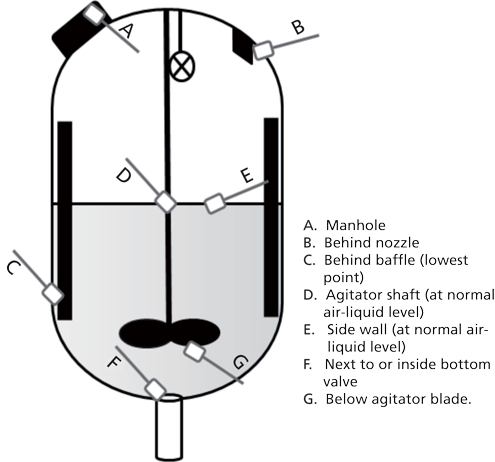
Sampling sites should be defined based upon the geometry and design of the equipment, materials of construction, hard-to-clean areas, and locations that may have a higher risk to product contamination (i.e., risk assessment), or they may be based on historical reference from similar equipment on site (i.e., benchmark). The riboflavin testing used for spray device qualification in CIP systems also helps in identifying areas that must be sampled due to limited coverage.
Risk-based surface sampling locations and testing performed
A risk assessment should be performed to minimize the number of sampling sites. Table II is an example of a list of sampling sites and assigned risk factors.
A risk assessment should also be performed to minimize the number of tests performed, such as microbial, detergent, or active ingredient testing. For example, a TOC swab may be able to demonstrate removal of the large molecule API as well as the cleaning agent used. A single UHPLC swab may be able to demonstrate the removal of multiple detergents that are used in separate wash steps of the cleaning procedure (17). Applying a scientific, risk-based rationale can drastically reduce the number of samples taken as well as testing performed.
Table II. Risk assessment of surface sampling locations. MOC is material of construction. CLICK TO ENLARGE

Surface sampling recovery studies
Surface sampling recovery studies using swabs, wipes, or direct sampling techniques should be performed as part of the design stage to ensure that testing of the surface can meet predefined acceptance criteria. Surface sampling should define the swab or wipe used, surface location sampled, surface area sampled, material of construction of the surface, number and condition of the swab(s) or wipe(s), sample storage and stability conditions, swab or wipe diluent, and sampling accessories; qualified analysts should perform the testing. The surface sampling recovery study should also consider, if applicable, the swab or wipe wetting solution and various spiked amounts on the surface. The spiked amount and design of the surface sampling recovery test should challenge the sampling and analytical procedure.
The analysis of swab recovery from various active pharmaceutical ingredients as well as cleaning agent residues from a single site using various materials of constructions (including metals, plastics, and elastomers) supported that stainless steel could be used as a representative surface for swab recovery (18). Forsyth, et. al. pooled recovery factors from 16 sites, 29 different materials, and hundreds of samples. The reported recovery factor from a formulated alkaline cleaning agent, CIP 100 detergent, from 316 stainless steel was 93% (18).
Visual inspection
Visual inspection is important to ensure that the equipment looks sufficiently clean to proceed with analytical testing. There are limitations, similar to surface sampling, with routine visual inspections, such as large equipment or lengths of piping, as well as the time and resources required for proper visual inspection. Visual inspection can be defined as the process of using the unaided eye as the sensing mechanism from which judgments can be made about the condition of a unit to be inspected. A visual non-uniformity on equipment surfaces may present as an interruption of the normal pattern or grain either by residue or discoloration in amount as perceived by the unaided eye. This non-uniformity could be on the surface, such as visible residue, particulate matter, pooling of liquid, or rouge (oxides) or within the surface, such as scratches, corrosion, or etching.
During the design and qualification stages of the lifecycle model, a correlation between visual inspection, surface sampling, and rinse sampling should be performed, so that a visual inspection or rinse sample can be scientifically justified to determine that the equipment, piping, or parts are cleaned. Visual inspection as the method to assess for cleanliness is ideal for small parts or open process equipment that are easy to inspect. However, “visually clean” as the only acceptance criterion will require a justifiable, scientific rationale that will need to be defended when inspected (15). Several published articles have evaluated the use of visual inspection procedures and the role of visible cleanliness in control of critical variables, as well as establishing visible residue limits of select analytes.
Visible residue limits
In 1993, Fourman and Mullen specified a visual limit of small- molecule active ingredients of 1 to 4 mcg/cm2 (19), and this article was referenced in the FDA guide to cleaning validation (1) as well as Parenteral Drug Association (PDA) technical report 29 (20). Forsyth et al. have published several articles that include testing and defining critical variables as well as presenting various case studies. The case studies include spiking a 1 cm2 surface with residue at various concentrations and on different substrates. Once the residue is dried, it can then be inspected visually at different distances, angles, light intensities, with the use of mirrors, and by different analysts (21, 22). By defining the operators’ qualifications, visual inspection tools and conditions, procedures, and training and retraining activities, a company can quantify and validate the visual inspection procedure. The Sidebar describes a VRL case study for a biopharmaceutical facility.
Sidebar: visible residue limit case study
A large biopharmaceutical manufacturer was designing a new facility for the final compounding and filling of their product. This standard parenteral facility consists of an automated parts washer, steam sterilizer, automated vial washer, depyrogenation tunnel, filling machine, closure machine to insert stoppers, capping machine, and product labeler. This product was being filled by a contract manufacturing organization (CMO), which was using only water for cleaning.
During the design phase of the cleaning program, coupon testing was performed by coating the finished product onto stainless-steel coupons and evaluating the cleaning with water and a formulated alkaline cleaning agent to remove the finished product. Water-only cleaning at ambient to 80 oC was not sufficient to yield a visual clean and water-break free surface. Cleaning the coupons with water was successful in meeting the gravimetric testing of around 1–2 mcg/cm2. In support of a visual inspection program of the items being washed in the parts washer, a visible residue limit (VRL) study was performed on the final drug product as well as on a formulated alkaline cleaning agent on stainless-steel and glass surfaces.
The VRL study procedure consisted of precleaning and drying 304 stainless-steel coupons with a 2B finish as well as borosilicate-glass coupons. The roughness of the 304 stainless coupons was comparable to the 316L stainless-steel specifications for the filling parts. The formulated acid and alkaline cleaning agents as well as the finished product were compatible with 304 stainless steel, so the use of these coupons as a test substrate versus 316L was justified. The test samples were serially diluted, and 1 mcl of diluted sample and 20 mcl of low TOC de-ionized (DI) water were applied over a 1-cm2 area. The sample was then allowed to air-dry at ambient temperature for at least 16 hours.
After drying, the coupons were inspected by two analysts, in duplicate, at one of the following distances (0.45 m, 1.0 m, and 1.5 m); lighting conditions (250 lux, 500 lux, and 1000 lux); viewing angles (30o, 45o, and 90o); and with and without a viewing mirror. A light meter (Cooke Corporation Cal-Light 400 lux), digital protractor, and 1–5 mcl syringe (Hamilton) were used in the study. The acceptable results for both analysts on two coupons per set for the formulated alkaline cleaning agent are noted in Sidebar Figure 1. The borosilicate glass surface was used in the construction of the viewing endcap on the final formulation compounding tank, so the higher VRL observed was not critical.
Visual inspection training
The visual inspection procedure as well as the inspector qualification study consisted of precleaning and visual inspection of the coupons before spiking. An analyst receives a yearly eye exam with 20/20 vision (glasses or contact lenses are acceptable), wears safety glasses during visual inspection, and is informed that some coupons may not contain a sample. This procedure is used to try to eliminate phantom residues or false positives.
The coupons were placed flat on a table in front of a fume hood in groups of three, and the inspector stood back approximately 0.85 m and inspected the coupons at a 50o angle. The groups of three coupons were mixed in order as seen in Sidebar Table I. The lighting in the room was between 500 and 1000 lux.
An acceptable result is that the inspector identifies all coupons with a loading of 10 mcg/cm2 and 12 out of 15 of the remaining coupons.
Sidebar Figure 1 and Table I.
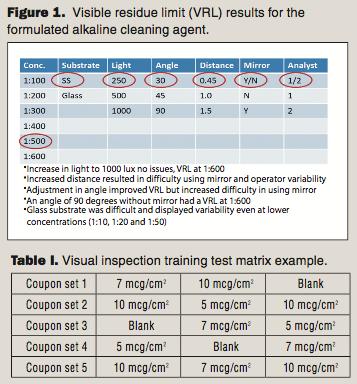
Rinse sampling
Rinse sampling is commonly used to evaluate surface cleanliness of closed production equipment, hoses, and piping commonly cleaned by CIP systems (23–25). The advantages of rinse sampling are that the entire surface can be sampled, with no disassembly of equipment and no direct sampling of the surface, and that rinse sample analysis via conductivity, TOC, UV, and other methods in-line or on-line can be adapted to PAT technologies. The disadvantages of rinse sampling are that the analyte measured may not be soluble in the rinse solution, rinsing may not pick up the residue due to poor coverage during rinsing, and the analyte may be too diluted in the rinse solution volume.
Rinse recovery studies
Rinse recovery studies can be used in addition to assessing the solubility of the active ingredient in the rinse solution. The studies are performed by adding a specified concentration, around the acceptable limit, of the residue on the surface. The selection of the residue, conditioning of the residue, surface material, roughness of the surface, rinse solution, volume of rinse solution per surface area, rinse solution temperature, and flow rate should all be considered in setting up a rinse solution recovery study.
Two rinse recovery studies are discussed as examples. The first rinse recovery case study includes a linearity between concentration and conductivity of a formulated alkaline cleaning agent (Figure 6) as well as the recovery factor from stainless steel, polytetrafluoroethylene (PTFE), rubber, and glass surfaces (Table III). The second rinse recovery case study includes a linearity between concentration and TOC of a formulated alkaline cleaning agent (Figure 7) as well as the recovery factor from stainless steel, PTFE, rubber, and glass surfaces (Table IV).
Figure 6. First rinse recovery study; linearity between conductivity to concentration of a formulated alkaline cleaning agent.

Figure 7. Second rinse recovery study; linearity between total organic carbon (TOC) and concentration of a formulated alkaline cleaning agent.
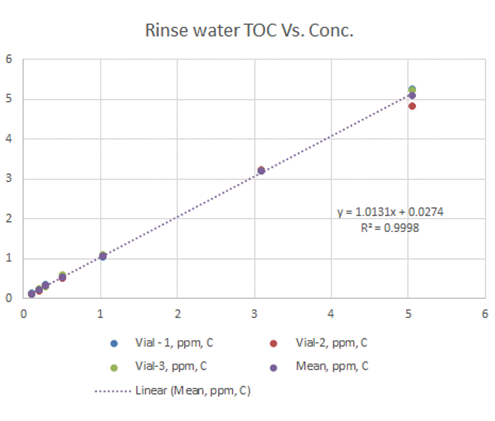
Table III. Conductivity and pH results, 24-hour air-dried samples. CLICK TO ENLARGE.Table IV. Total organic carbon (TOC) results, 24-hour air-dried samples. CLICK TO ENLARGE.
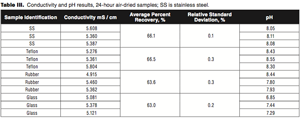
Three lots of the formulated alkaline cleaning agent were diluted at various concentrations between 1 and 100 ppm by volume using DI water and tested at ambient temperature. A conductivity meter (Radiometer/Copenhagen CDM83) was used, and the conductivity probe was standardized following the manufacturer’s recommendations with 50 and 100 mcS/cm standards prior to testing. Temperature compensation was not used for this testing. The conductivity to concentration curve is reported in Figure 6.
Three lots of the formulated alkaline cleaning agent were diluted at various concentrations between 0.1 and 5 ppm C by volume using DI water and tested at ambient temperature. A laboratory TOC analyzer (Sievers 900) was used for testing, and the TOC analyzer was standardized following the manufacturer’s recommendations with reference standards for sucrose and benzoquinone. The TOC to concentration curve is reported in Figure 7.
Rinse recovery testing was performed by applying 1 +/-0.1 g of the prepared 0.24% w/w formulated alkaline cleaning agent to about 100 cm2 area of one side of the stainless steel, PTFE, glass, and rubber coupons using an analytical balance (Mettler Toledo XS). Solution was applied in drops to provide a uniform coverage. Samples were air-dried on the coupons in a horizontal position. After drying, 300 mL of DI water at ambient temperature was poured from a squeeze bottle over the coupon so that the flow cascades down the face of the coupon for approximately 30 seconds. The collected rinse water was agitated for 30 seconds to ensure uniformity, then 39 mL was poured into a labeled TOC vial, sealed, and measured for TOC (Sievers 900 laboratory TOC analyzer). The TOC recovery results are reported in Table IV. The remaining sample (39 mL) was measured for conductivity (Fisher Scientific AB30 conductivity meter). The conductivity recovery results are reported in Table III.
Conclusion
Surface cleanliness is crucial in ensuring that process residue, cleaning agent residue, and bioburden do not adversely affect the safety, quality, and potency of the drug manufactured. Surface cleanliness can be determined through surface sampling, rinse sampling, and visual inspection. The preferred method is surface sampling through swabbing, wiping, or direct measurement. Surface sampling can add production delays, increased sampling costs, and often increased safety risk to the analyst. If the engineering of the equipment, coverage testing of the equipment, and cleaning agent and analytical method selection have been well vetted during the design and qualification stages of the lifecycle approach, then rinse sampling or visual inspection can be successfully used to demonstrate surface cleanliness. Attention to detail and application of a risk-based approach during the design stage can provide justification for using either rinse sampling or visual inspection in determining surface cleanliness.
Acknowledgement
The authors are grateful to Amanda Deal for excellent technical assistance in performing the VRL study as well as the first and second rinse recovery case studies.
References
1. FDA, Guide to Inspections Validation of Cleaning Processes (July 1993).
2. Health Canada, Guide-0028 Cleaning Validation Guidelines (Jan. 2008).
3. PIC/S, PE-006-3 Validation Master Plan Installation and Operational Qualification Non-Sterile Process Validation Cleaning Validation (Sept. 2009).
4. FDA, Process Validation: General Principles and Practices (Jan. 2011).
5. FDA, Guide for Industry. PAT-A Framework for innovative pharmaceutical development, manufacturing, and quality assurance (Sept. 2004).
6. ICH, Harmonised Tripartite Guideline-Q9 Quality Risk Management (Nov. 2005).
7. E. Rivera, “Basic equipment-design concepts to enable cleaning in place: Part I,” Pharm. Tech. Equipment and Processing Report (June 15, 2011), accessed Oct. 10, 2017.
8. G. Verghese and P. Lopolito, “Cleaning Engineering and Equipment Design,” in Cleaning and Cleaning Validation Volume I, P. Pluta Ed. (DHI Publishing and the Parenteral Drug Association, 2009) pp 123-150.
9. J. Voss, Cleaning and Cleaning Validation: A Biotechnology Perspective pp 1-39 (PDA, Bethesda, MD, 1996).
10. ASME, Bioprocessing Equipment (BPE) p. 52 (2012).
11. G. Verghese and N. Kaiser, “Cleaning Agents and Cleaning Chemistry, Chapter 7” in Cleaning and Cleaning Validation Volume I, P. Pluta Ed. (Davis Healthcare International and Parenteral Drug Association, 2009) pp 103-121.
12. P. Lopolito, “Critical Cleaning for Pharmaceutical Applications, Chapter 17” in Handbook for Critical Cleaning Applications, Processes and Controls, Second Edition, B. Kanesgsberg and E. Kanesgsberg, Eds. (CRC Press, Taylor & Francis Group, 2011).
13. H.J. Kaiser, J.F. Tirey, and D.A.LeBlanc, J. Val. Tech. 6 (1) 424-436 (1999).
14. H. J. Kaiser and B. Ritts, “Validation of Analytical Methods Used in Cleaning Validation,” J. Val. Tech. 10 (3) (May 2004).
15. European Commission, Good Manufacturing Practice Medicinal Products for Human and Veterinary Use-Annex 15, Qualification and Validation (2015).
16. P. Lopolito and E. Rivera, “Cleaning Validation: Process Lifecycle Approach,” in Contamination Control in Healthcare Product Manufacturing, Vol 3. R. Madsen and J. Moldenhauer, Eds. (DHI Publishing, PDA Books, 2014).
17. M. Gietl, B. Meadows, and P. Lopolito, “Cleaning Agent Residue Detection with UHPLC” Pharm. Manufacturing (April, 2013), www.pharmamanufacturing.com/articles/2013/1304_SolutionsTroubleshooting/, accessed Oct. 10, 2017.
18. R. L. Forsyth, J.C. O’Neill, and J.L. Hartman, Pharm. Tech. 31 (10) 103-116 (2007).
19. G. L. Fourman and M.V. Mullen, Pharm. Tech. 17 (4) 54-60 (1993).
20. PDA, Technical Report No. 29 (Revised 2012) Points to consider for cleaning validation. (Bethesda, MD, 2012).
21. R.J. Forsyth, V. Van Nostrand, and G.P. Martin, Pharm. Tech. 28 (10) 58-72 (2004).
22. D. A. LeBlanc, J. Pharm. Sci. Tech. 56 (1) 31-36 (2002).
23. D. A. LeBlanc, Rinse sampling for cleaning validation studies, Pharm. Tech. 12 (5) 66-74 (1988).
24. B. Bunimovich, P. Lopolito, and B. Meadows, J. Val. Tech. p. 62-69 (Winter 2011).
25. K. Bader, et al., Pharm. Eng. 29 (1) 8-20 (2009).
Article Details
Pharmaceutical Technology
December 2017
Vol. 41, No. 12
Pages: 28–37
Citation:
When referring to this article, please cite it as E. Rivera and P. Lopolito, "Evaluating Surface Cleanliness Using a Risk-Based Approach," Pharmaceutical Technology 41 (12) 2017.
About the Authors
Paul Lopolito is a senior technical services manager and Elizabeth Rivera is a technical services manager, both at the Life Sciences Division of STERIS Corporation in Mentor, Ohio.

Pharmaceutical Tariffs Are Imminent: How Industry is Bracing for Impact
April 16th 2025On April 14, 2025, the Trump Administration launched a national security-driven investigation into pharmaceuticals, a move that will likely result in tariffs being placed on pharmaceutical drugs, ingredients, and other components that are imported from outside of the United States.